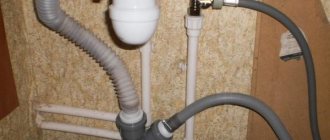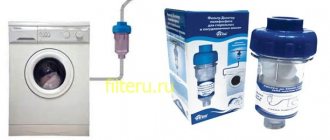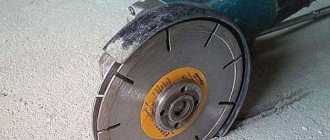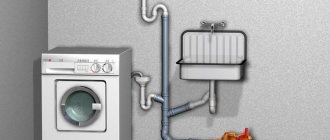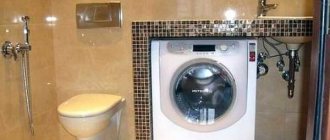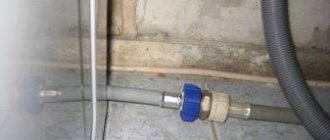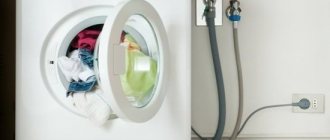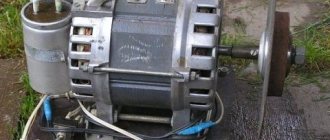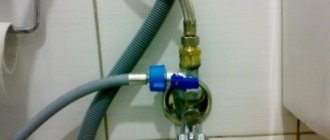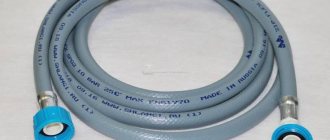Installation and connection of the dishwasher can be divided into 3 stages:
- preparation and securing of built-in equipment in a special niche
- connection to the electrical network
- connection to water supply and sewerage
Let us consider in detail, indicating common errors, precisely the stages of installation to utility networks and communications.
Electrical connection
To connect the dishwasher to a 220V network, you will not need many materials:
- three-core copper cable VVGnG-Ls 3*2.5mm2
- 16A socket “Schuko” type with grounding contact
- RCD or diffavtomat 16A with leakage current 30mA
A dishwasher (DMM) is not a particularly powerful consumer of electricity, such as a hob (from 7 kW and above). Its power usually does not exceed 2.0-2.5 kW.
Modern energy consumption models correspond to class “A” or “A+”. That is, in a year, approximately 220 kW will run on your meter.
Despite this, it is still advisable to connect the PMM at the repair stage to lay an independent cable line in a separate groove.
If your renovation has been completed a long time ago, and after purchasing the equipment you don’t feel like scratching the walls again and ruining the wallpaper, then you can make do with the existing outlet. Just be sure to make sure that it is protected by an RCD.
Connecting a dishwasher through a simple modular machine is extremely dangerous.
The socket should be placed at a convenient height - up to 90cm from the floor level.
At the same time, place it on the right or left side of the washing machine, but not behind it.
Please also take into account the fact that the total length of the cord with plug for this equipment rarely exceeds 1.0-1.5 m. Based on this, choose a place for the outlet so that you don’t have to use an extension cord later.
The outlet itself must, of course, be grounded. But not everyone has this same grounding. Especially in apartments in old high-rise buildings.
Therefore, many people use regular ones, and everything seems to work fine. However, the level of protection will no longer be sufficient.
Roughly speaking, if there is a grounding contact and there is a current leak, then you will not even be able to turn on the RCD. The consequences of these leaks, even small ones, can be quite lethal.
With a simple socket, the shutdown will occur only at the moment when you touch the body, which is already energized.
And you will still feel this electric shock, at least at the initial moment.
Installation steps
The process of installation and connection to utilities can be divided into several stages:
- Choosing an installation location where the installation of built-in and fully built-in appliances will be carried out, in fact, this issue should be thought through before purchasing a dishwasher for the kitchen.
As a rule, all built-in kitchen equipment (for example, Hotpoint Ariston LST) comes in standard sizes, so there should not be any problems with installation in the set.
As an example, here is a table of dimensions for Bosh models:
| The lineup | Height (cm) | Width(cm) | Depth (cm) |
| SMS (69M68, 63N02, 53N12, 50E02, etc.) | 85,0 | 60,0 | 60,0 |
| SPS 53M02 | 85,0 | 45,0 | 60,0 |
| SKS (50E16, 40E02) | 45,0 | 55,0 | 50,0 |
As you can see from the table, the SMS dishwasher model cannot be installed in the space planned for the SKS, which is 45 cm high.
It should be noted that some Siemens models, for some reason, may differ in size from the standard, therefore, before making a purchase, we recommend that you first measure the device so that you do not have to redo the headset later.
Please note that installation rules prohibit placing dishwashers near electric stoves, as well as under the stove or above the oven.
After installing the machine in place, you need to check that its doors close properly.
- At the second stage, it is necessary to organize drainage into the sewer.
- Connection to water supply.
- Power supply.
- Level adjustment and installation check. We would like to note that almost the entire Electrolux model range (for example, ESL 94201 LO), Bosh (SGS, SPV, SRV) and Hansa are very critical of tilt angles. For normal operation of such devices, the deviation from the vertical (in any direction) should not be more than 2°, so in such cases you cannot do without a level.
If there are no difficulties with the first and last stages, then in the rest there are certain nuances that require detailed consideration. As a rule, the installation instructions (attached to each dishwasher) contain all the necessary information. We recommend that you read it, after which you can begin preparing your tools.
Connection to water supply and sewerage
Connecting the dishwasher to the water supply can be done in two ways.
The first is when you are at the stage of construction or major renovation, and you can afford to lay separate pipes, trench walls, etc.
The second is when your entire kitchen has already been installed and all finishing work has been completed. At the same time, you bought a dishwasher and you need to connect it all somewhere, to the existing water supply and sewerage system with minimal alterations and hassle.
Final work
After you have connected everything yourself according to the previously described diagrams, you just need to look at how the equipment stands. Namely, it is necessary to check the stability of the device in terms of level, as well as carry out a control check of all work.
Regarding the level: after installing the PMM, you need to use a building level to use it to see which legs need to be tightened so that the machine stands as level as possible. Even a slight misalignment can adversely affect the operation of the device, and this is regardless of the brand, be it Bosch or Beko.
After this, we activate the test mode, the essence of which is based on washing without dishes. You need to see how quickly the water drains and refills. It is important to re-examine all connections and their joints, this will protect you from leaks. To connect the dishwasher correctly, you need to remember to test the operating mode; this will allow you to quickly eliminate all the existing nuances before you start the machine full of dishes.
Installation of new pipes
For major installation you will need a varied range of materials:
- polypropylene pipe PPR PN20 with a diameter of 20mm
- water socket
- union nut connectors
- 90 degree connection fitting PPR-90
- HP/HP elbow with ¾" external thread
- FUM sealing tape
When installing pipes, the socket method is used. To do this, you will need a special apparatus for soldering polypropylene pipes.
The total length of the pipe and the number of fittings are selected individually. This depends on how far the dishwasher is from the cold water collector.
To begin with, mark the route where the pipes will be laid from the distribution manifold to the installation site of the PMM.
Then, use a wall chaser to cut to the required depth.
Next, connect the PPR connectors with a union nut to one of the manifold outputs.
Cut a piece of pipe so that it will last until the first turn or corner. At the same time, do not forget to leave a margin of 15mm for connections on each side.
Connect the pipe and fittings using the soldering method, controlling the position of the elbow.
After connecting all the pipes along the marked area, install a water socket at the very end. Be sure to fix it on the wall.
Next, screw a ¾-inch male threaded elbow into the water socket.
Mount the water supply hose onto the angle.
The AquaControl or AquaStop system with which it may be equipped should protect against leaks in the event of a breakdown and automatically stop the water supply.
Turn on the water and check the entire system. If everything is fine, you can finally seal the groove.
How to install a front on a built-in dishwasher door
There are two ways to attach the facade:
- Partial fastening. In this case, the panel covers the main part of the door, while the control panel remains visible.
- Full installation. The dishwasher door is completely covered by a panel.
The finished front panel is attached only with self-tapping screws. The use of glue, even very durable one, is undesirable. Most likely, due to constant changes in temperature, it will become unusable and lose its properties.
When using self-tapping screws, make sure that they fit firmly into the material, but do not come out of it either from the front or back side. Otherwise, there is a high risk of injury and equipment damage.
The facade is fastened starting from the handle. To carry out this work, dishwasher manufacturers make special holes on the door and also offer templates for fixing the parts.
Upon completion of installation, check how smoothly the façade is installed and whether there are any gaps. If you are satisfied with the appearance, you can begin to directly operate the PMM.
Drain connection and installation in the kitchen opening
All that remains is to connect the drain hose from the PMM to the sewer outlet through an adapter collar of the appropriate diameter.
Do not forget that the drain pipe must be mounted at an angle, allowing for a 1cm height difference per 1m of length.
And the drain hose itself has a bend at 70cm from the floor. That is why it is attached to the top of the dishwasher, and not at all so that it does not dangle.
All that remains is to connect the washing machine to a power outlet and check the functionality of the entire system. Then secure it in a specially prepared opening.
By the way, some models, for example from Siemens, have non-standard sizes. Therefore, think about your kitchen furniture in advance.
When installing in an opening, do not forget about the metal plate that must be nailed to the bottom of the tabletop (for the Bosch model).
This thing is mounted at the very edge and is a vapor barrier, like a screen. With it, the countertop will not swell from steam.
For some reason, many people throw it out and replace it with aluminum tape, securing it both to the table top and to the side walls of the car.
Electrolux, instead, comes with something like a piece of rubber that sticks on the sticky side.
After installation and connection, the first wash should be done without dishes, using powder or special cleaning tablets.
This procedure should destroy all bacteria and deposits formed after long-term storage in the store.
Choosing a location
You need to choose the location of the equipment before purchasing the PMM. If you decide to build a dishwasher into your kitchen furniture, you need to know the dimensions of the corresponding niche. It can be located under the countertop, cooking panel or under the sink .
Approximate size ratio of niche and built-in dishwasher
The place to install the dishwasher should be close to the sink , which is already connected to the water supply and sewerage system. If the distance to communications exceeds 1.5 meters, problems may arise in the operation of the device.
Washing machine and dishwasher built next to the sink
Make sure that there is an electrical outlet . Since the dishwasher consumes quite a lot of electricity, it is dangerous to use an extension cord to operate the PMM, especially if several devices will be connected to it.
The extension cord must not be placed behind the rear wall of the PMM
For a compact dishwasher that can be placed directly on the countertop, the issue of supplying communications is easier to solve, since it can be easily placed as close to the sink as possible. This option is optimal when there is no niche with the required dimensions in the furniture. There is no need to make a connection to the sewer at all; just place the drain hose in the sink.
Connection via sink siphon and faucet.
There is a simpler option for connecting a dishwasher, in which there is no need to install separate pipes for draining and supplying water.
You only need to change two things:
- standard siphon under the sink to a special one
It differs in that its design already has a place for connecting the drain hose - a fitting, and sometimes two.
You can, of course, redo the sewer drain by installing an additional pipe and seal there.
The whole thing is inserted by hand, without using any special tools.
However, do not forget that connecting dishwashers and washing machines directly to the sewer pipe may be accompanied by the appearance of unpleasant odors.
Experts advise making this connection through a check valve.
Kinking or bending the hose at a height, which should act as an alternative to the valve, only helps with constant use of the equipment. Of course, your water will not return.
However, if the system stands for a couple of weeks without work and water (for example, in a country house or in a country house), everything will dry out and the stench in the kitchen will be very sensitive.
- the second thing you need to install is a tee with a ¾-inch thread
Through it, the water itself will flow into the machine. It is installed instead of the standard connector that goes from cold water to the mixer.
Screw this tee to the cold water supply hose or pipe.
Next, change the siphon. Unscrew the screw from above, holding the siphon itself from below so that it does not fall.
Disconnect the drain from the sewer. To do this, simply pull it towards you with force. It should come out of the rubber retainer.
Assemble a new siphon from the components, not forgetting the gaskets, and install it in place of the old one.
Connect the flexible drain pipe to the sewer pipe. All that remains is to connect the dishwasher drain hose to the siphon tube through a special adapter.
Included with this adapter, be sure to look for a valve, it blocks the reverse flow of water.
Fill the sink with water and check that there are no leaks anywhere.
Grounding electrical wiring
PMM is one of the most dangerous equipment from the point of view of electrical safety. And since the kitchen has the most equipment, the tension increases accordingly. Therefore, it is necessary to have a grounding connection when installing the PMM.
If there is a grounding, there is a possibility that the phase voltage of the electrical network will appear on the device body in the event of a break in the neutral wire. This kind of situation can act as a catalyst for electric shock to a person. Now you know how to properly prepare the electrical wiring for installing the machine.
First launch of PMM
Before starting, you will have to activate the test wash, since there is a possibility that the parts and elements inside the machine are lubricated, this will allow you to wash it inside, thereby getting rid of dirt and dust. You can see how the machine works, whether it hums, how quickly the water fills, how much detergent is needed, whether it is necessary to add salt or rinse aid. If you are connected to hot water directly, look at the quality of the water, whether there are streaks or stains on the dishes.
Be sure to turn the sprayer over before turning it on to see if it rotates normally. After this, pull out the filter and see if it is intact. Fill in the gel, add salt, and on the control panel you will have to indicate the type of product you are using. We launch the PMM and observe the work. If you hear any strange sounds or see a leak, all this can be corrected. Don't forget that you will need to let the machine dry and cool. Once you understand how to use the equipment, you can start washing dishes if all defects are absent or eliminated.
What materials are facades made of?
Cladding facade panels made of different materials are supplied to the market. Models made from MDF are popular. Medium density fiberboard is resistant to moisture and temperature changes. MDF does not emit toxic substances harmful to health. The plate is durable and reliable. It is necessary to choose a panel that will match the color of other furniture items.
Particleboard is considered the most affordable in terms of cost. But this material has a number of disadvantages, the most important one being its short service life. Chipboard panels quickly deform. When integrity is compromised, hazardous substances are released.
It is very rare that natural wood is chosen for the facade, because the material is expensive and requires special care. For decoration, a thin layer of wood called veneer is often used. This façade gives the structure a solid appearance.
Although some use PVC film, which experts do not recommend. The operation of a dishwasher is associated with the generation of heat, which leads to its rapid peeling and loss of its original properties. The facade can be finished with metal, glass, plastic.
Thanks to the decorative coating, it is possible to hide the structure. Once the surface is finally processed, it is impossible to guess that there is a dishwasher behind it. It looks like an ordinary kitchen cabinet.
If you choose the right fittings and use different decorative elements, you can emphasize the originality of furniture accessories and give the surface a finished look. Before installing the front on the dishwasher, you can watch the video. Be sure to follow all recommendations. If you strictly follow the advice, the decorative panel can be installed in a short time, without spending a lot of effort.
Top 10 reliable built-in dishwashers with discounts
Selection of components
Parts and tools for a Siemens dishwasher are basically no different from other brands. There are some features:
- Aquastop hose. Not all machines are equipped with leakage protection. Therefore, you can purchase it separately. Give preference to original Siemens or Bosch parts. Although the latter are not always suitable.
- Drain and fill hoses are often short. If they are not long enough for you to connect, it is better not to use extension cords. Also purchase Siemens brand elements that will fit your model 100%.
The mountings and connections of the Siemens dishwasher are quite non-standard. Therefore, be prepared for the fact that you will have to buy additional parts or adjust the system for connection.
- tee (brass or bronze) with shut-off valve;
- flow filter;
- siphon with two outlets;
- clamps, gaskets;
- waterproofing tape;
- two hoses.
The operating instructions may also indicate additional components:
- Pressure stabilizer. This is a special valve that will protect equipment from pressure drops, water hammer and other troubles.
- Network stabilizer. For powerful devices, it is recommended to install an automatic circuit breaker that will protect the electronic component from damage as a result of a power surge.
- Set of tap and hose for connection to hot water supply.
Having prepared everything you need, you can begin installing the dishwasher.
Types of facades, functions
The facade for PMM is decorative cladding that harmonizes with kitchen furniture. Attaches to the car door. MDF panels are practical and durable. They can be laminated, covered with colored film, attached with original fittings and various decorative elements. Hanging chipboard or PVC is a big risk. These materials are easily deformed by vibration, high temperature, and moisture.
Sheathing functions:
- Simplifying the choice of technology. You don’t have to worry about the color of the case, but focus on the technical characteristics, since the dishwasher won’t be visible anyway.
- Child protection. A car hidden behind the door will not become a “victim” of children's curiosity.
- Noise isolation. An additional panel absorbs noise. German built-in models, such as Siemens, Bosch, Miele, Hansa, are equipped with special noise-absorbing gaskets that are inserted between the door and the front panel.
Types of fastenings
The casing can be attached to the door with self-tapping screws (option for fully built-in models), or secured on hinges (for partially built-in models). Slider mounts are often used in Gorenje, Ikea, Electrolux, and Beko modifications.
Sheathing dimensions
Depends on the dimensions of the PMM. The standard width of the machine is 60 cm (full size), 45 cm (narrow). The common height is 82 cm. Dimensions may differ greatly from standards. We recommend purchasing the set after purchasing a dishwasher. So that it can fit perfectly under the countertop and lock into place. For example, Ikea kitchens fit all models of dishwashers; they sell custom-made household appliances. If the façade is larger than the door, it will rest against the plinth when opened.
Dishwasher Siemens
- How to choose
- Features of the models
- Advantages and disadvantages
- Best models
- Which is better: Siemens or Electrolux?
- Capacity
- Energy consumption
- Noise level
- Drying type
- Additional options
The Siemens company produces household appliances that are distinguished by reliable German quality. A wide audience of buyers around the world were able to experience first-hand the advantages of the manufactured equipment and become fans of the brand, despite the high prices of the products.
